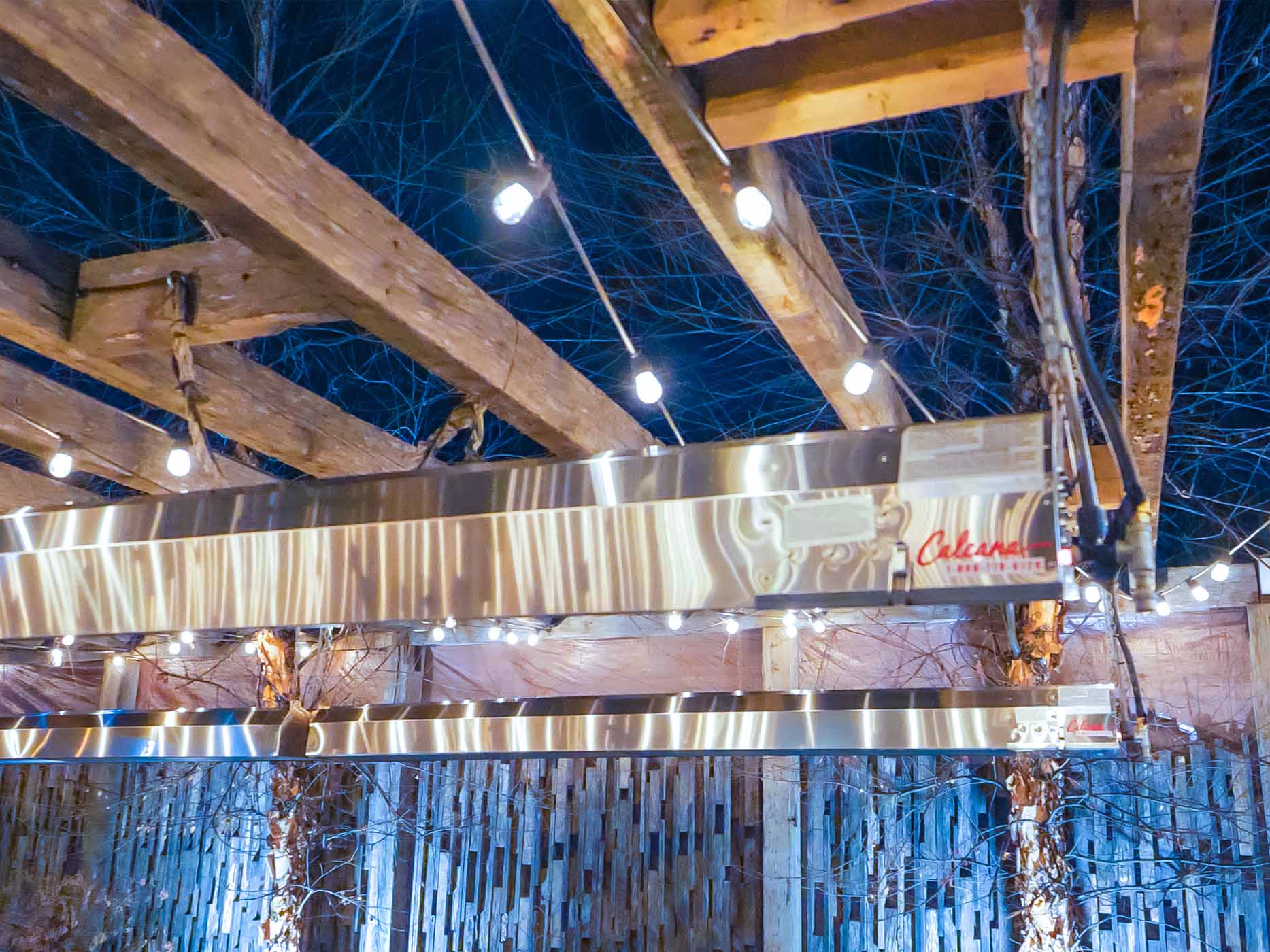Infrared heaters are among the most efficient and comfortable ways to bring warmth to outdoor and indoor spaces alike. From restaurant patios and garages to warehouses and residential backyards, these systems have become a trusted solution for creating cozy, energy-efficient environments. But one of the most common questions that arises before installation is: Do infrared heaters require special wiring or outlets?
The short answer is, it depends on the type of heater, its power source, and where you plan to install it. While some models are plug-and-play, others require hardwiring or connection to specific circuits to operate safely and effectively.
In this comprehensive guide, we’ll cover everything you need to know about electrical requirements for infrared heaters, including voltage, amperage, outlet types, circuit load, and professional installation tips. We’ll also discuss the unique requirements of Calcana’s infrared gas heaters, which differ from electric models and provide a flexible, high-performance heating solution without the same wiring concerns.
Understanding Power Requirements, Installation Needs, & Electrical Considerations for Infrared Heating Systems
Before diving into wiring details, it’s important to understand why proper electrical setup is crucial for any infrared heating system. Infrared heaters rely on converting energy, whether electricity or gas, into radiant heat that warms objects and people directly, not just the surrounding air.
For electric models, this process draws a significant amount of power. A small residential plug-in infrared heater might use a standard 120V outlet, but larger patio or commercial models often require dedicated 240V circuits. Incorrect wiring can lead to tripped breakers, overheating, or even electrical fires.
On the other hand, gas-powered infrared heaters like those from Calcana are typically fueled by natural gas or propane and use electricity only for ignition and control, meaning they don’t demand high-power electrical circuits. This makes them far easier to install in many outdoor and commercial settings.
The goal of this article is to help you determine what’s required for your specific setup, and why choosing the right power configuration from the start ensures both safety and performance.
Types of Infrared Heaters & Their Power Needs
Infrared heaters come in several configurations, each with its own power source and installation requirements. Let’s look at the main categories:
2.1 Electric Infrared Heaters
Electric infrared heaters use electrical resistance to produce radiant heat. These are popular for indoor environments, small patios, and areas where running a gas line isn’t practical.
-
Low-power plug-in models: Often 120V, under 1,500 watts. These can plug directly into standard outlets.
-
High-power commercial models: Typically 208V, 240V, or even 277V units. These require hardwiring and dedicated circuits due to higher amperage draws.
2.2 Gas Infrared Heaters
Gas infrared heaters, such as Calcana’s models, operate using natural gas or propane. They burn the fuel in a controlled chamber and emit infrared radiation that heats surfaces below.
-
Electrical use: Minimal. Usually only needed for ignition and thermostat controls.
-
Wiring needs: A simple low-voltage connection or a small electrical line for ignition systems.
-
Outlet type: Often just a standard 120V outlet for control wiring, if needed.
2.3 Hybrid & Specialty Systems
Some industrial systems combine gas and electric features or use multiple heating zones controlled by smart thermostats. These may require specialized electrical work, especially when integrated with building management systems.
In short, while electric infrared heaters often demand special wiring or outlets, gas infrared heaters like Calcana’s eliminate most of those challenges, offering high-performance radiant heating without complex electrical infrastructure.
Understanding Electrical Basics for Infrared Heaters
To determine what kind of outlet or wiring setup you’ll need, it helps to understand a few key electrical concepts:
3.1 Voltage (V)
Voltage refers to the electrical potential difference. In North America, typical household voltage is 120V, while heavy-duty appliances use 240V. Many commercial heaters operate at higher voltages to produce more heat output efficiently.
3.2 Amperage (A)
Amperage measures how much electrical current flows through a circuit. If your heater draws more amps than the circuit can handle, it will trip the breaker. That’s why dedicated circuits are often required for higher-wattage heaters.
3.3 Wattage (W)
Watts = Volts × Amps.
This formula determines how much energy your heater uses and helps electricians size your circuit properly.
For example:
-
A 1,500W heater at 120V draws 12.5 amps (1500 ÷ 120 = 12.5).
-
A 4,000W heater at 240V draws about 16.7 amps (4000 ÷ 240 = 16.7).
3.4 Dedicated Circuits
A dedicated circuit is one that powers only one appliance or device. Many higher-wattage infrared heaters require a dedicated 20A or 30A circuit to operate safely.
If you’re not sure whether your electrical system can handle it, an electrician can test your panel and verify available capacity.
Electric Infrared Heater Wiring Requirements
4.1 Standard Plug-In Models
If you’re using a small plug-in infrared heater, like a personal garage or room heater, you can typically plug it into a standard 120V outlet. Make sure the circuit isn’t overloaded with other high-power devices.
Avoid using extension cords, as they can overheat under heavy load.
4.2 Hardwired Units
Larger patio or commercial units (2,000–6,000 watts) require hardwiring into a 208V or 240V circuit. These installations should always be performed by a qualified electrician, especially in outdoor or wet locations.
4.3 GFCI Protection
Outdoor electric infrared heaters should always be connected to GFCI (Ground Fault Circuit Interrupter) protected outlets to prevent electrical shock in damp conditions.
4.4 Control Wiring
If your heater uses a wall switch, dimmer, or thermostat, these components must be compatible with the heater’s voltage and amperage. Incorrect controllers can cause failure or void warranties.
Wiring Needs for Gas Infrared Heaters
This is where Calcana infrared heaters stand out. Unlike electric systems that depend entirely on electrical power, Calcana’s gas infrared heaters primarily run on natural gas or propane, with minimal electrical requirements.
5.1 Low Voltage or Standard Outlet Power
Most models only need a standard 120V outlet to power the ignition system or control board. Some even operate with low-voltage wiring, simplifying installation even further.
5.2 No Heavy-Duty Wiring
Because the heater’s main energy source is gas, there’s no need for high-voltage circuits or specialized outlets. This reduces both installation cost and complexity.
5.3 Easier Compliance
Gas infrared heaters often meet building and safety codes more easily since they don’t draw heavy electrical loads. Electric units, on the other hand, must be carefully rated for circuit capacity and environment (especially for damp or outdoor use).
5.4 Simpler Expansion
If you ever want to add more heaters later, a gas-powered setup allows for easy expansion without rewiring your entire electrical system.
Installation Tips: Safety, Code, & Professional Help
Infrared heater installation involves both safety and code compliance. Whether your system is electric or gas-powered, it’s important to:
-
Consult an electrician or HVAC technician before installation.
-
Confirm voltage and amperage requirements based on the heater’s manual.
-
Follow local building codes, especially for outdoor or commercial spaces.
-
Use proper mounting clearances to ensure safe radiant coverage.
-
Avoid overloading circuits or sharing circuits with other large appliances.
Even if you’re a skilled DIYer, remember that electrical work carries inherent risks. A certified professional ensures your system runs safely and efficiently.
Comparing Electric vs Gas Infrared Wiring Requirements
| Feature | Electric Infrared Heaters | Gas Infrared Heaters (Calcana) |
|---|---|---|
| Power Source | Electricity only | Natural gas or propane |
| Voltage | 120V, 208V, 240V+ | Minimal 120V or low voltage for controls |
| Circuit Requirement | Dedicated circuit required | Usually none beyond control wiring |
| Installation Complexity | Moderate to high | Low |
| Cost | Higher (due to wiring needs) | Lower (simpler setup) |
| Ideal For | Small indoor/outdoor spaces | Large outdoor/commercial patios |
As you can see, gas infrared systems simplify installation dramatically, especially for large-scale or multi-unit heating layouts.
Common Mistakes in Infrared Heater Installation
Even with simple wiring, mistakes can lead to poor performance or safety hazards. Common errors include:
-
Using undersized circuits or incorrect breakers.
-
Failing to check voltage compatibility before connecting.
-
Skipping GFCI protection in outdoor settings.
-
Mounting heaters too close to ceilings or flammable materials.
-
Running too many heaters on one circuit.
Always cross-reference manufacturer guidelines and verify all connections before powering up.
When to Call a Professional
If you’re unsure about your wiring setup, see any of these signs:
-
Breakers trip when the heater turns on.
-
The heater doesn’t reach full temperature.
-
Flickering lights or power dips occur when it’s running.
-
You’re uncertain which circuit powers the outlet.
A licensed electrician can inspect your system and ensure it’s wired safely and up to code. For gas models, a certified gas fitter should handle the fuel line connections.
Final Thoughts: Choosing the Right Setup for Your Space
So, do infrared heaters require special wiring or outlets?
Electric infrared heaters — often, yes. They may need dedicated high-voltage circuits, specific outlets, and GFCI protection.
Gas infrared heaters (like Calcana’s) — generally, no. They rely primarily on natural gas or propane, requiring only minimal electrical connection for ignition or control.
If you’re looking for an outdoor or commercial heating solution that avoids costly electrical upgrades, Calcana infrared gas heaters are the clear choice. They deliver powerful, consistent radiant warmth with flexible installation, long lifespan, and unmatched efficiency.
No special wiring. No heavy circuits. Just reliable, comfortable heat, exactly where you need it.




Leave a comment
This site is protected by hCaptcha and the hCaptcha Privacy Policy and Terms of Service apply.